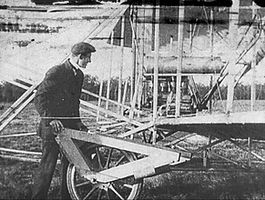
T0
In a nutshell...
From da Vinci's dreams to the Wright brothers' first flight, from Vuia's innovations to Dragomir's safety invention, from Coandă's fluid dynamics to Earhart's pioneering journeys, and from Rossy's jet-powered adventures to Richard Browning's futuristic flight suit – the history of aviation is a captivating tale of human ambition and ingenuity, forever changing the way we soar through the skies.
In the world of aviation, the journey began with the brilliant mind of Leonardo da Vinci, the famous Italian Renaissance polymath. Though he never saw his dreams take flight, his detailed sketches, designs, and observations of flying machines laid the foundation for understanding aerodynamics and flight principles.
And if we look closely at these moments...

Late 1400s.
The inception of aviation can be traced back to the ingenious mind of Leonardo da Vinci, a renowned Italian Renaissance polymath.
Although he never witnessed the realization of his visionary flying machines, his meticulous sketches, designs, and observations formed the bedrock of our comprehension of aerodynamics and flight principles in the realm of aviation.

1903
Centuries later, in 1903, the Wright brothers, Orville and Wilbur, made history with their power-driven, heavier-than-air machine.
They achieved the first free, controlled, and sustained flights, soaring for a mere 12 seconds and covering 36 meters. This achievement marked the birth of modern aviation.


1906
However, across the ocean, in 1906, on a different continent, another pioneer named Traian Vuia built and flew the first "heavier-than-air" machine with a self-contained propulsion system and landing gear.
His historic flight in Montesson, France, with the "Vuia I" aircraft, was a significant milestone that paved the way for future developments in flight technology.

1930
Fast forward to 1930 when Romanian inventor Anastase Dragomir introduced the world's first usable ejection seat for aircraft.
This invention dramatically improved pilot safety by enabling quick escapes from malfunctioning aircraft in emergency situations.

1930
In the 1930s, Henri Coandă's discovery of the Coandă effect added a new dimension to aviation technology.
This phenomenon allowed the controlled manipulation of fluid streams, leading to advancements in aircraft lift and stability.
It also found applications in industrial systems for efficient exhaust and noise reduction and even in everyday devices like hand dryers for directed airflow.

1932
As aviation continued to evolve, trailblazers like Amelia Earhart took to the skies.
In 1932, she became the first woman to fly solo across the treacherous Atlantic Ocean. Her daring spirit and determination inspired generations of aviators.

2008
In the modern era, the skies witnessed remarkable feats. Yves Rossy, known as "Jetman" revolutionized flight with his jet-powered wing suits.
From crossing the English Channel in 2008 to navigating the Grand Canyon and even flying alongside airplanes, he expanded the horizons of personal flight, leaving the aviation world in awe.
2012
Then came Felix Baumgartner, whose Red Bull Stratos mission in 2012 captured global attention.
He performed a record-breaking freefall jump from the stratosphere, advancing knowledge about high-altitude and supersonic freefall.

Today, the 21st century...
... innovation continues. British inventor and entrepreneur Richard Browning introduced the "Daedalus" flight suit in 2017.
Equipped with multiple miniaturized jet engines, Browning achieved vertical take-off and controlled flight, resembling a real-life Iron Man suit.
With the "Daedalus" suit, Richard Browning achieved something straight out of science fiction
The fusion of humans and machines allowed him to take to the skies in unimaginable ways.
The suit enabled vertical takeoff and controlled flight, showcasing the potential of personal flight technology in the modern era.


.jpeg)


